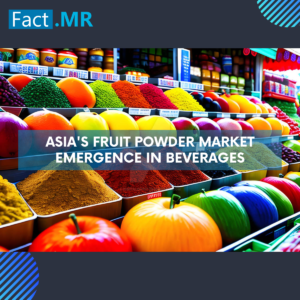Fruit powder is obtained by dehydrating fruits into a fine-drying powder through methods like freeze-drying, spray-drying, or air-drying. This process involves removing the water content from the fruit, leaving behind a fine, concentrated powder. The fruit powder market in Asia is expected to witness rapid growth, driven by evolving consumer preferences, technological advancements, and innovative product formulations. While flavor remains a key consideration, the focus has now extended to textures and mouthfeel, changing the way fruit powders are incorporated into beverages and other applications. Consumers use fruit powders in various things like making smoothies, baking, or adding flavor to drinks. It’s a popular choice because it’s convenient and has a longer shelf life compared to fresh fruit. Plus, it retains most of the nutrients and flavors of the original fruit. As more people look for healthy and natural ingredients, the demand for fruit powders keeps growing.
Fruit powder business is experiencing steady growth due to increasing consumer demand for natural ingredients. Leading fruit powder companies are investing in innovative manufacturing processes to meet rising market demand. According to Fact.MR, the market for fruit powder is anticipated to be valued at US$ 54.55 billion by 2024 & further grow at a 6.7% CAGR through 2034.
As the fruit powder market in Asia continues to evolve, the emphasis on textures and mouthfeel alongside flavor represents a significant paradigm shift in product development and consumer engagement. By capitalizing on emerging trends, insights, and drivers, stakeholders in the fruit powder industry are tapping new opportunities for innovation, differentiation, and market expansion.
- Enhanced solubility and customized particle size are the leading trends in the fruit powder market. Asia is known for its rich culinary heritage and diverse tastes. Different regions within Asia have unique preferences for flavors and textures. Enhanced solubility and customized particle size allow manufacturers to cater to these diverse preferences more effectively.
- For example, in Southeast Asia, where tropical fruit flavors are popular, such as mango, pineapple, and coconut, fruit powders with improved solubility can be readily incorporated into traditional beverages like smoothies, juices, and desserts.
- Asian consumers often associate a smooth and refreshing mouthfeel with high-quality and natural ingredients. Manufacturers are investing in technologies such as advanced spray drying technologies to improve the solubility of fruit powders in liquid solutions, ensuring smoother texture and better dispersibility. As a result, there’s a growing demand for fruit powders that deliver an authentic and fresh taste experience, mimicking the texture of freshly prepared fruit juices or purees. Fruit powder manufacturers play a crucial role in supplying high-quality products to meet diverse consumer needs. The growing fruit powder demand is driven by consumers seeking convenient and nutritious alternatives.
- In countries like Japan and South Korea, known for their technological advancements and innovation, there is a strong emphasis on product quality and functionality. Advanced spray drying techniques and encapsulation methods play a crucial role in improving the solubility and stability of fruit powders, meeting the high standards set by consumers in these markets.
- Particle size plays a crucial role in determining the mouthfeel and sensory experience of fruit-infused beverages. By customizing the particle size of fruit powders, manufacturers can achieve desired textures, ranging from smooth and creamy to pulpy and textured, catering to diverse consumer preferences. For instance,
- In India, where traditional beverages like lassi (yogurt-based drink) and sharbat (sweetened fruit drink) are cherished for their rich textures, manufacturers often opt for larger particle sizes in fruit powders.
- This creates a textured mouthfeel that resonates with the preferences of Indian consumers, who appreciate beverages with a substantial and satisfying consistency. Additionally, in the booming market for fruit-flavored milkshakes and smoothies, finely ground fruit powders are utilized to achieve a smooth and creamy texture that enhances the indulgent experience.
- Similarly, in China, where tea-based beverages and fruit-flavored milk teas are immensely popular, particle size customization is essential for delivering the desired mouthfeel. Finely ground fruit powders are commonly used in fruit-flavored milk teas to create a silky-smooth texture that complements the tea base. On the other hand, larger particle sizes may be preferred in traditional Chinese herbal drinks, providing a more textured and authentic drinking experience.
- In India, where traditional beverages like lassi (yogurt-based drink) and sharbat (sweetened fruit drink) are cherished for their rich textures, manufacturers often opt for larger particle sizes in fruit powders.

What are the factors driving the growth of the fruit powder market?
The fruit powder market comprises several small and medium-sized local players with substantial shares. The size of the fruit powder market is growing due to the emergence of private label players, increased penetration of wholesale players, and consolidation of distribution channels. Moreover, continuous innovation in product formulations and manufacturing processes is driving the growth of the fruit powder market in Asia. Manufacturers are leveraging advancements in food science, flavor technology, and ingredient sourcing to develop novel fruit powder products that meet evolving consumer preferences and market demands.
- Rising Demand for Functional Beverages: The growing awareness of health benefits associated with functional ingredients has fueled the demand for fruit-infused functional beverages. Fruit powders serve as versatile ingredients, enabling the development of a wide range of functional beverages targeting specific health concerns such as immunity, digestion, and energy enhancement.
- Expanding Applications in Food Industry: Fruit powders find extensive applications beyond beverages in the food industry, including confectionery, bakery, dairy, and snack products. Their versatility and long shelf life make them ideal ingredients for flavoring, coloring, and fortification, driving their adoption across diverse food categories.
- Growing health consciousness among consumers: With growing health consciousness, there is a rising demand for natural and nutritious ingredients. Fruit powders, derived from real fruits, are perceived as healthier alternatives to artificial flavorings and additives, driving their adoption in various food and beverage products.
- Busy lifestyles and on-the-go consumption habits have fueled the demand for convenient food and beverage options. Fruit powders offer the advantage of easy storage, handling, and transportation compared to fresh fruits, making them popular choices for instant beverages, smoothies, and snacks.
- Consumers are increasingly scrutinizing product labels and seeking transparency regarding ingredients and manufacturing processes. Fruit powders align with the clean label trend, as they are often free from artificial colors, flavors, and preservatives, appealing to health-conscious consumers seeking wholesome options.
However, the market is expected to witness growth in the next 10 years in Asia. Having said that, the fruit powder market also faces various challenges in the region. One of the primary concerns revolves around maintaining the desired texture profile of fruit powders throughout the production process. Achieving a fine, consistent texture is crucial for enhancing the solubility and dispersibility of the powder, ensuring optimal reconstitution in various applications such as beverages, baked goods, and snacks.
The fruit powder business is thriving as manufacturers explore new formulations and flavor profiles. As the market expands, fruit powder companies are capitalizing on emerging trends to drive product innovation and growth.
Factors such as variations in fruit characteristics, processing methods, and storage conditions can impact the texture of the final product. Collaborative efforts among industry players, research institutions, and regulatory bodies are essential to overcome these challenges and drive continuous improvement in texture quality, enhancing the appeal and versatility of fruit powder products in the Asian market.




